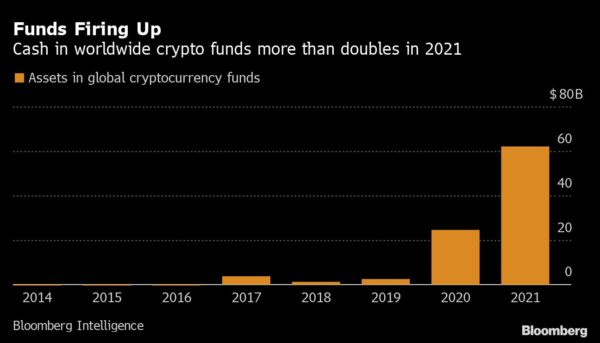By Katherine Greifeld
Even beyond the launch of the first U.S. Bitcoin futures ETF, cryptocurrency funds notched some notable global milestones in 2021.
The number of crypto-tracking investment vehicles worldwide more than doubled to 80 from just 35 at the end of 2020, according to Bloomberg Intelligence data. Assets soared to $63 billion, compared to $24 billion at the start of the year.

Crypto is claiming an ever bigger share of the global investment landscape as inflation concerns mount and speculative forces continue to percolate — despite sometimes hair-raising volatility. Bitcoin, the world’s largest cryptocurrency, suffered a 56% drawdown from April to June before hitting an all-time high in November, only to fall more than 30% in the following weeks. But that has done little to dent a record flood of cash.
“Globally, it’s obviously a phenomenon that’s starting to take off,” Leah Wald, chief executive of crypto asset manager Valkyrie Investments, said on Bloomberg’s “QuickTake Stock” streaming program. “If you look at inflows on a volume perspective, not only has it been steady even with the price corrections that Bitcoin is notoriously famous for, but you’re seeing a lot of institutions jump in.”
Grayscale Investments LLC is the largest asset manager in the digital-assets space, with the $30 billion Grayscale Bitcoin Trust ranking as the world’s largest crypto fund. Fund providers such as Michael Novogratz’s Galaxy Digital Holdings and Bitwise Asset Management also control billions.

While the majority of 2021’s fund launches were outside the U.S., the October debut of the ProShares Bitcoin Strategy ETF (ticker BITO) was the biggest attention-getter. It took just two days for the fund to accumulate $1 billion, making it one of the busiest starts for an ETF on record. The initial surge in interest showed the degree of pent-up demand for crypto exposure among U.S. investors in ETFs. And yet, unlike an ETF directly connected to spot Bitcoin, these futures-backed products are vulnerable to so-called roll costs associated with managing contracts. It’s likely that investor demand would be even higher if physically backed funds were allowed to launch in the U.S., according to Bloomberg Intelligence.
“I can’t help but think that the assets in this space would be even larger if we had more efficient structures, like spot ETFs, in the U.S.,” said James Seyffart, Bloomberg Intelligence ETF analyst.
Indeed, flows into the ProShares fund have stalled, with the ETF down more than 30% since its mid-October launch. Meanwhile, similar products from Valkyrie and VanEck have less than $70 million in assets combined.
Valkyrie’s Wald is optimistic that flows will pick up in 2022. Institutional money managers are likely waiting to see how the U.S. futures-backed ETF handle the roll costs, she said.
“That specific vehicle, I think a lot of money managers want to look at the metrics before jumping in,” Wald said. “We’re excited about what next year has to hold.”
More stories like this are available on bloomberg.com.




